#C-UAS (Counter-Unmanned Aerial Systems)
Explore tagged Tumblr posts
Text
Terra Drone and Toshiba Join Forces to Expand Drone Safety and Management

Toshiba offers a comprehensive anti-drone security solution that tackles potential threats posed by malicious drones. Their expertise in radar systems allows them to develop cutting-edge solutions to safeguard customers against emerging threats in the evolving airspace. Toshiba remains dedicated to ensuring air safety through innovative technologies, as the drone industry continues to introduce novel services and applications.
#drone safety#drone management#UTM (Unmanned Traffic Management)#C-UAS (Counter-Unmanned Aerial Systems)#Terra Drone#Toshiba#Urban Air Mobility (UAM)#drone regulations#airspace integration#drone accidents#secure drone operations#advanced air mobility solutions#drone traffic management system#counter drone systems#anti-drone technology#commercial drone use#drone industry growth#drones uav#drone
0 notes
Text

U.S. F-16 Fighters Shot Down Drones with Laser-Guided Rockets in Combat
F-16 APKWS shoot drones
The U.S. Air Force has officially employed for the first time laser-guided 70mm rockets in the air-to-air role during operations in the Red Sea over the course of 2024. The Advanced Precision Kill Weapon System II (APKWS II) guided-rockets were deployed from F-16 Viper multirole fighter jets to engage hostile drones launched by the Houthis, the Iranian-backed Yemeni militia.
The U.S. Air Force confirmed that F-16 fightes used Advanced Precision Kill Weapon System 70mm guided rockets in the air-to-air role in combat to shoot down Houthi drones.The APKWS IIU.S. Operations in the Red Sea against the Houthis
The U.S. Air Force has first announced back in 2019 that the APKWS II, originally developed as a low-cost air-to-ground precision munition, had been tested successfully in the air-to-air role, but until now no operational use of the weapon in this role has been disclosed. The details of the combat debut of the APKWS II in this new role are still scarce, with no knowledge of how many guided rockets were employed, how many Houthi drones have been shot down with the weapon, and the exact timeline of the engagements.
A U.S. official told to The War Zone few days ago that the APWKS II air-to-air capability was first employed last year “as one of many options for countering the Houthi UAS threat.” The official added that “It is a lower-cost option compared to the AIM-9X. That lower cost is one of the benefits of using it.”
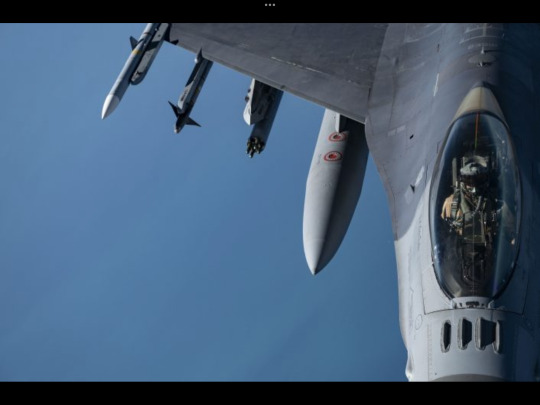
A U.S. Air Force F-16 Fighting Falcon is refueled over the U.S. Central Command area of responsibility Dec. 17, 2024. [Author’s note: : the aircraft is armed with a 7-round rocket launcher.] (U.S. Air Force photo)
The APKWS II
The AGR-20 Advanced Precision Kill Weapon System II (APKWS II) is a conversion of the Hydra 70 unguided rockets which adds a laser guidance kit to the baseline weapon, turning it into a precision-guided munition (PGM). The Hydra 70 is itself derived from a previous weapon, the 2.75-inch (70 mm) Mk 4/Mk 40 Folding-Fin Aerial Rocket (FFAR) of the late 1940s, a system widely employed in the Korean and Vietnam wars.
By adding a guidance section to a cheap rocket (inserted in the middle of the rocket, between the 10-pound high-explosive warhead at the front and the Mk66 Mod 4 rocket motor at the rear), the U.S. Air Force has therefore been able to obtain low-cost smart munitions that can be used in the air-to-ground role. These are particularly useful when the full warhead of larger bombs (like JDAM) and missiles (like the AGM-65 Maverick or AGM-114 Hellfire anti-tank missiles) is not needed to obtain the desired effects or not suitable due to the danger of collateral damages.
The guidance section of the APKWS includes four foldable wings with wing-mounted laser seeker collection optics with a wide field of view which enable to engage both moving and stationary targets. BAE Systems, which produces the weapon, says that “no modifications are required to the rocket, firing platform or fire control system,” with the only known modification being a longer variant of the LAU-131/A 7-round rocket launcher normally employed by the U.S. Air Force, called the LAU-131 A/A (the Navy uses the AGR-20 with the similar LAU-68 F/A).
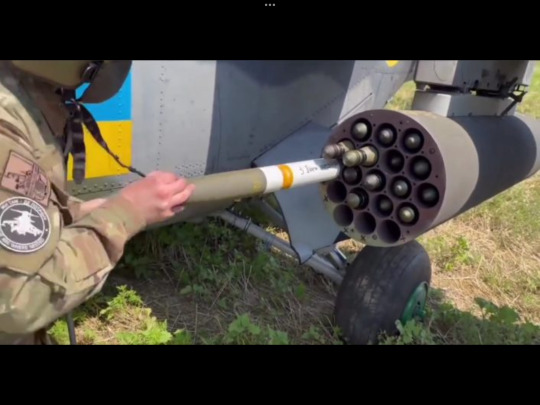
Ukrainian airman loading an American-made Hydra 70 unguided rocket into a rocket pod of a Czech-delivered Mil Mi-24V helicopter. (Image credit: Screenshot from X video)
The APKWS is also being used in a novel surface-to-air mode as a Counter-Unmanned Aircraft Systems (C-UAS) to engage low-flying, slow and cheap drones. Specifically, the weapon has been included in the Electronic Advanced Ground Launcher System (EAGLS) employed by the U.S. military in the Middle East and the U.S.-supplied VAMPIRE (Vehicle-Agnostic Modular Palletized ISR Rocket Equipment) used by Ukraine to counter Russian drones.
The U.S. Navy also announced in late 2023 that it was about to deliver a new proximity-fused warhead for APKWS II rockets, optimized for use against drones, albeit developed ostensibly for the surface-to-air role. However, further developing an air-to-air capability out of these older rockets is another impressive feat for the U.S. Air Force, that has now the possibility to engage targets at a very small fraction of the cost of other existing missiles.
While a current beyond visual range radar-guided AIM-120 Advanced Medium Range Air-to-Air Missile (AMRAAM) is priced at more than $1 million each and an AIM-9X Sidewinder Block II has a price tag of around $420,000, the guidance section of an APKWS II only costs around $15,000, with the full APKWS II round only costing a few thousand dollars more (to include the warhead and the motor).
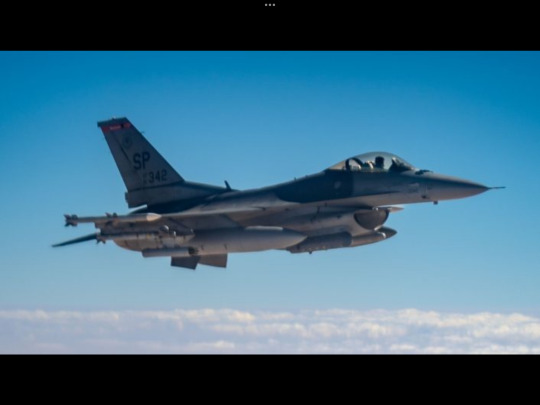
A U.S. Air Force F-16 Fighting Falcon flies a routine presence patrol mission over the U.S. Central Command area of responsibility, Jan. 25, 2025. [Author’s note: : the aircraft is armed with a 7-round rocket launcher.] (U.S. Air Force photo by Staff Sgt. Jackson Manske)
The low cost of the APKWS II comes with some restrictions, as the weapon is shorter ranged than the current USAF missiles, and the warhead is also smaller. However, against slow and cheap targets like drones, the AGR-20 can provide the Air Force with a highly cost-effective weapon.
Moreover, the APKWS II can provide American jets with deeper magazines for air-to-air munitions, as they can be carried in a 7-shot rocket pod on a single hardpoint that could otherwise take only a single AIM-9X or AIM-120 missile. The F-16 is also able to carry two LAU-131/As with the standard 70 mm unguided rockets on each pylon by using a triple ejector rack, although it is unclear if this capability is also available for the LAU-131A/A with the AGR-20.
This feature could come in hand while facing swarm or saturation attacks from enemy drones, a tactic that has already been used by Russia in their aggression of Ukraine, by Iran in their attacks on Israel and sometimes on a smaller scale even by the Houthis. The high cost of the interceptors against these cheap targets and the magazine size of the launching platforms have been two of the main concerns highlighted by forces countering these attacks.
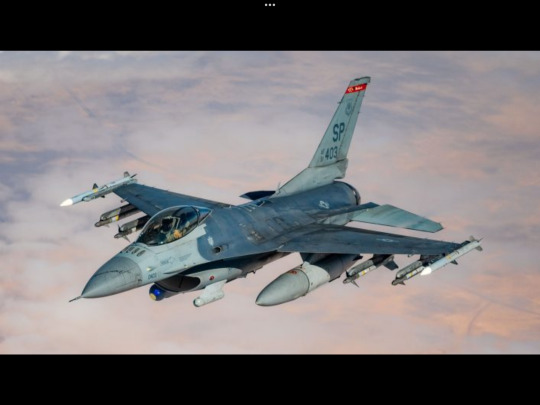
A U.S. Air Force F-16 Fighting Falcon flies a routine presence patrol mission over the U.S. Central Command area of responsibility, Jan. 25, 2025. [Author’s note: : the aircraft is loaded with a mix of AIM-120C, AIM-9M and AIM-9X missiles and accompanies the fighter armed with the APKWS] (U.S. Air Force photo by Staff Sgt. Jackson Manske)
U.S. Operations in the Red Sea against the Houthis
The U.S. military has been involved since late 2023 in operations with a multi-national coalition in the Red Sea, in the Gulf of Aden and in the area of the Bab el-Mandeb strait against the Iranian-backed Houthi militia operating out of Yemen. The Houthis started attacks on civilian shipping in the area after the terrorist attack of Hamas on Israel of Oct. 7, 2023.
To support Hamas, Houthis employed both aerial and naval drones, in addition to missile attacks, against shipping routes while also launching sporadic long-range drone and ballistic missile attacks on Israel. After the UN Security Council adopted Resolution 2722 in January 2024, condemning the Houthi attacks and reaffirming the freedom of navigation, the United States launched Operation Prosperity Guardian, aimed at protecting civilian shipping and reducing the Houthi threat, with the first airstrike against Houthis dating back to Jan. 12, 2024.
Over the course of one year, the warships and aircraft involved in Operation Prosperity Guardian have engaged multiple times Houthi targets, including land strikes to remove military capabilities from the terrorist group, and engagements to shoot down drones and missiles launched from Yemen.

The Carrier Air Wing 3, aboard the aircraft carrier USS Eisenhower (CVN-69), logged 14,000 sorties, 32,000 flight hours and 15,000 arrested landings during a lengthy deployment in the Red Sea, while its F/A-18E/F Super Hornets and E/A-18G Growlers shot more than 60 air-to-air missiles. Operation Prosperity Guardian also included the first long-range operational use of B-2 stealth bombers against Yemen, with the stealth bombers flying all the way from their home base at Whiteman Air Force Base in Missouri, and the combat debut of the F-35C carrier-based stealth fighter jets.
Interestingly, the U.S. Navy recently announced that an MH-60R Seahawk helicopter, an upgraded variant of the original UH-60 Black Hawk developed for naval use, has been involved in the shoot-down of a Houthi drone, but it is unclear what weapon was involved and when this happened. Probable candidates for the achievement are however restricted to only a few weapon system, including the AGM-114 Hellfire missile, the very AGR-20 Advanced Precision Kill Weapon System (APKWS) also used by U.S. Air Force’s F-16s, or on-board machine guns.
MH-60R shoots down drone

An MH-60R Sea Hawk prepares to land on the flight deck aboard the Arleigh Burke-class guided-missile destroyer USS Cole (DDG 67) in the U.S. Central Command area of responsibility. (Image credit: U.S. Navy Seaman Mark Pena)
@TheAviationist .com
14 notes
·
View notes
Text
Why Aren’t We Using Counter-Drone Tech in NJ?
Counter-Unmanned Aerial Systems (C-UAS) Clusters of unidentified drones have been buzzing around New Jersey, raising eyebrows and concerns, especially near critical infrastructure. The U.S. has top-tier counter-drone systems—tech designed to track and neutralize UAVs—yet they aren’t being deployed here. Instead, officials are focused on monitoring and investigating, leaving the public wondering:…

View On WordPress
#Aerial threats#Counter-drone tech#Counter-UAV#Critical infrastructure#Drone sightings#Emergency disruptions#FBI investigation#New Jersey drones#Public safety#Security concerns#Surveillance tech#Tech response#UAV#Unresolved mystery
2 notes
·
View notes
Text
🚨 Controversial Update
The U.S. Department of Defense just sent yet another massive aid package to Ukraine—this time worth $125 million
This new shipment includes:
- Counter-Unmanned Aerial Systems (C-UAS) equipment
- HIMARS ammunition, 155 mm & 105 mm artillery shells
- TOW missiles, Javelin & AT-4 anti-armor systems
- HMMWV ambulances, small arms ammo, and more
Let us know what you think. Should we keep sending military aid to Ukraine, or is it time for a different approach?
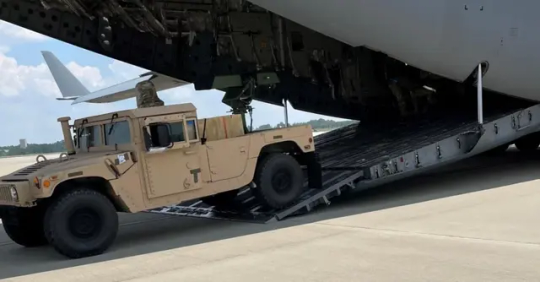
3 notes
·
View notes
Text
0 notes
Text
Indian Army launched special operation Shiva for Amarnath Yatra
The Army has launched 'Operation Shiv' to ensure security of the Amarnath Yatra and has deployed 8,500 soldiers on both routes leading to the cave shrine and other related locations and has also set up an unmanned aerial system (C-UAS) grid .
The Army has launched 'Operation Shiv' for the security of the Amarnath Yatra and has deployed 8,500 soldiers on both the routes leading to the cave temple and other related places and has also established an unmanned aerial system ( C - USS ) grid. An official gave this information on Friday. The 38-day long Amarnath Yatra started on July 3 through two routes. These are the traditional 48-km-long Nunwan-Pahalgam route in Anantnag district and the 14-km-long Baltal route in Ganderbal district. The Yatra will conclude on August 9.
More than 8,500 troops have been deployed
The defence spokesperson said, "The Indian Army has launched 'Operation Shiva' in close coordination with the civil administration and Central Armed Police Forces to ensure smooth and safe conduct of the Amarnath Yatra." He said, "More than 8,500 troops have been deployed under this year's enhanced security architecture, facilitated with extensive technical and operational resources."
Shows the unwavering commitment of the Indian Army
Giving details of the major deployments and tasks under 'Operation Shiv', the spokesperson said a 'Counter-UAS Grid' with over 50 'C-UAS' and 'Electronic Warfare (EW)' systems has been established to neutralise drone threats, apart from regular 'UAV' missions and live monitoring of the Yatra routes and the holy cave. The spokesperson said 'Operation Shiv' reflects the unwavering commitment of the Indian Army to ensure safe, seamless and spiritually gratifying journey for all devotees visiting the holy pilgrimage
What is Operation Shiva?
For the safe and smooth conduct of the Amarnath Yatra, the Indian Army has launched Operation Shiva. Under this, more than 8,500 soldiers have been deployed with state-of-the-art equipment. More than 50 anti-drone systems have been installed. High resolution cameras and drones are being used to keep an eye on the convoy of pilgrims.
Is Shivlinga the private part of Shiva?
No, Shivlinga is not Shiva's private part. Shivlinga is a religious symbol that represents the formless form of Lord Shiva. It is considered a symbol of Shiva's energy and power.
Read more: Air India Crash: Both pilots were completely fit, report shocks everyone
Tags:# Amarnath Yatra newsOperation Shiv news
0 notes
Text
0 notes
Text
DroneSentry Secured 2023 IRONMAN Texas with Advanced Counterdrone Defence
DroneSentry Secured 2023 IRONMAN Texas with Advanced Counterdrone Defence
The Montgomery County Office of Homeland Security and Emergency Management (MCOHSEM) once again relied on DroneShield’s counterdrone technology to ensure the safety and security of the 2023 IRONMAN Triathlon Championships in Woodlands, Texas. This marked the second consecutive year that the DroneSentry system was deployed at this internationally recognised event.
The Memorial Hermann IRONMAN Texas is a major athletic championship attracting thousands of spectators and requiring over 4,000 volunteers. With such a large public presence across an extensive racecourse, the risk of unauthorised drone activity presents a significant security concern. Disruptions from rogue drones can endanger bystanders, interfere with event operations, and obstruct authorised drone use for live media coverage.
To counter these risks, the DroneSentry system was strategically deployed along multiple points to deliver full-spectrum counterdrone protection across the race zone. The system’s integration of C-UAS AI and multi-sensor technology provides robust real-time drone defence by detecting, identifying, and tracking unmanned aerial systems. The setup included RfOne Mk2 radio frequency sensors, RadarZero radar, and the DroneOpt1 electro-optic camera – all linked through the DroneOptID platform for AI-powered identification and visual confirmation.
DroneShield’s counterdrone defence solutions are specifically designed for rapid deployment, even in complex environments like large-scale public events. The Universal Mounting System (UMS Mk2) ensures seamless installation of components, enhancing adaptability without compromising effectiveness.
This deployment highlights the expanding role of C-UAS systems in safeguarding public infrastructure and critical events. While DroneShield’s technology is also actively utilised in C-UAS airports, C-UAS prisons, and counterdrone stadiums, its application here demonstrates versatility in high-traffic civilian environments.
With a growing global need for resilient antidrone airports security, advanced electronic warfare, and proactive counterdrone strategies, DroneShield continues to deliver future-ready solutions that redefine operational safety.
0 notes
Text
NQDefense Counter-Unmanned Aerial Systems: Total UAV Security
The rise of drone technology demands robust security measures, and NQDefense Counter-Unmanned Aerial Systems deliver comprehensive solutions. Our C-UAS technology employs radar, RF disruption, and AI-enhanced tracking to counter UAV threats. Whether for defense, law enforcement, or commercial security, NQDefense Counter-Unmanned Aerial Systems provide unmatched drone mitigation capabilities. Prevent unauthorized surveillance, smuggling, and aerial attacks with cutting-edge C-UAS technology. Trust NQDefense to safeguard your airspace with precision and efficiency.
Know more: https://www.nqdefense.com/understanding-the-need-for-counter-unmanned-aircraft-systems/
#NQDefense #CounterUnmannedAerialSystems
0 notes
Text
https://github.com/botowola/plate/blob/main/Counter-Unmanned-Aerial-System-(C-UAS)-Market-The-Role-of-AI-and-Automation-in-Future-Growth.md
0 notes
Text
DRONE DESTROYER DEAL: Elbit Secures $60m NATO Contract to Crush Aerial Threats
Elbit Systems Ltd., an Israel-based defence technology company, announced on January 6, 2025, that it had been awarded a $60 million contract to provide its ReDrone Counter Unmanned Aerial Systems (C-UAS) to a European NATO country. The contract will be executed over a period of three years. The ReDrone solution, described by Elbit Systems as a modular, multi-sensor, and multi-mission system,…
0 notes
Text
Dronebuster: Countering the Growing Threat of Unmanned Aerial Vehicles
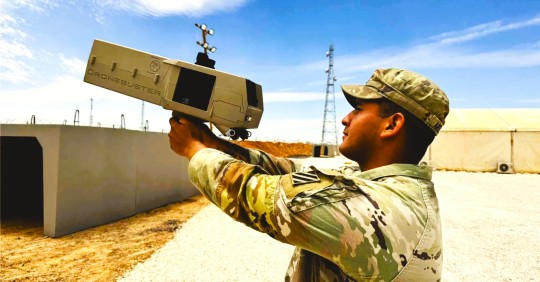
The recent Eager Lion 2024 military exercise in Jordan served as a crucial platform for the U.S. Army to showcase its advanced Dronebuster technology. This innovative system highlights the growing importance of counter-drone measures as unmanned aerial vehicles (UAVs), commonly known as drones, continue to surge globally.
#Dronebuster#Counter-drone#Unmanned Aerial Vehicle (UAV)#C-UAS (Counter-Unmanned Aircraft System)#Eager Lion Military Exercise#BLOS Vs LOS#Reconnaissance drone#U.S. Army#U.S. Department of Defense#NATO#drone#drones uav#military technology#military#military aircraft
0 notes
Text
Elbit Systems Wins $60 Million Order To Supply CUAS To A NATO Country
Elbit System CUAS Order for Nato Member: Elbit Systems Ltd., a leading Israeli defense electronics company, has been awarded a contract worth approximately $60 million to supply its advanced counter-unmanned aerial systems (C-UAS) solution to a NATO European country. The contract will be fulfilled over a three-year period. This significant win for Elbit Systems underscores the growing concern…
0 notes
Text
The anti-drone market in Germany is expected to grow at a CAGR of 26.8% during the forecast period.
The anti-drone market in Germany has experienced robust growth, fueled by a combination of government initiatives, private sector innovation, and rising concerns about drone misuse. The country invests heavily in technologies to detect, intercept, and neutralize unauthorized drones. Airports, critical infrastructure, and events with large public gatherings are particularly vulnerable to drone-related incidents, driving demand for technologically advanced counter-drone solutions. For instance, In June 2024, Rheinmetall and MBDA signed an agreement to integrate small anti-drone missiles into the Skyranger 30 and other military platforms. They signed a corresponding Letter of Intent (LOI) at ILA 2024.
Drones disrupting airport operations, spying on sensitive installations, or being used for illegal activities, including smuggling, have become alarmingly common. This has underscored the need for advanced technologies to detect and mitigate threats in real-time. Solutions incorporating radar, radiofrequency (RF) detection, and AI-powered analytics are already being deployed. At the same time, emerging technologies such as directed energy weapons (DEWs) and machine learning-enhanced systems elevate capabilities further. In July 2024, the German Army presented its Puma S1 Infantry Fighting Vehicle (IFV), currently in service, equipped with an innovative counter-drone (C-UAS) system, DedroneSensor RF-300, which is designed to detect, classify, and locate unmanned aerial vehicles (UAVs) and their remote-control signals passively.
As technologies such as 5G networks and quantum computing advance, they are expected to enhance the precision and effectiveness of counter-drone systems. Integrating AI and machine learning will also enable predictive threat analysis, ensuring faster and more accurate responses. Regulatory measures, including restrictions on drone operations near critical infrastructure and enhanced penalties for illegal drone use, have provided a strong foundation for market growth. Public-private partnerships have also proven instrumental. Companies including Diehl Defence, Rheinmetall AG, and HENSOLDT collaborate with government bodies to refine and deploy state-of-the-art counter-drone systems. By September 2021, German authorities had successfully tested an anti-drone system designed to safeguard restricted airport airspaces. The system, part of the Falke Project, was tested near Hamburg Airport and utilizes a combination of artificial intelligence (AI), integrated sensors, and simple yet effective technologies. Ground-based units detect unauthorized drones entering restricted zones around airports and interface with surveillance systems used by various facility stakeholders, allowing real-time location tracking of intruding drones.
Download PDF Brochure @ https://www.marketsandmarkets.com/pdfdownloadNew.asp?id=177013645
Regulatory complexities surrounding the use of anti-drone technologies, such as jamming devices, often create hurdles for deployment. Moreover, the high costs associated with developing and implementing advanced anti-drone solutions can discourage smaller businesses and municipalities from adopting these systems.
0 notes
Text
Anti-Drone Guns: The Future of Security and Defense
Anti-Drone Guns: The Future of Security and Defense
In the rapidly evolving world of technology, drones have found a significant place. However, with the increasing use of drones, the need for countermeasures has also grown. This has led to the development of anti-drone guns, a revolutionary tool designed to neutralize the potential threats posed by drones.Get more news about Anti Drone Gun,you can vist our website!
Anti-drone guns, also known as Counter Unmanned Aerial Vehicles (C-UAV), are a range of countermeasures designed to either destroy or immobilize a target drone. They come in various forms, from handheld weapons akin to traditional projectile guns to larger artillery-scale devices and even smart missiles.
One of the notable anti-drone guns is the DroneGun Tactical. This rifle-style device can jam and disrupt drones at long range. It operates on various frequencies and has a user-friendly interface, making it a preferred choice for military, government, and law enforcement users who need C-UAS protection.
Another significant anti-drone gun is the EDMS or EDMS SkyWiper. This portable electronic warfare anti-drone device is produced and developed by the Lithuanian company NT Service. It is designed to disrupt small and medium-sized UAVs by jamming their communication and satellite navigation systems with an electromagnetic pulse.
The way anti-drone guns work depends entirely on the system in question. Some physically destroy the drone using a projectile like a missile, while others use high-energy beams to either disrupt or destroy drones outright. Some systems disrupt the drone’s systems, like GPS, R/C, etc., while others physically capture drones midflight using things like nets.
The use of anti-drone guns has been seen in various military and law enforcement operations around the world. For instance, the EDMS-UA version of the device was first used by the Ukrainian Armed Forces against Russian separatist drones in Donbas. It has since seen further use in the Russian invasion of Ukraine, neutralizing Russian drones such as the Eleron-.
In conclusion, anti-drone guns represent a significant advancement in security and defense technology. As drones continue to evolve and find new applications, the importance of these countermeasures cannot be overstated. Whether it’s protecting sensitive installations, ensuring public safety, or neutralizing potential threats, anti-drone guns are set to play a crucial role in the future of security and defense.
0 notes
Text
0 notes